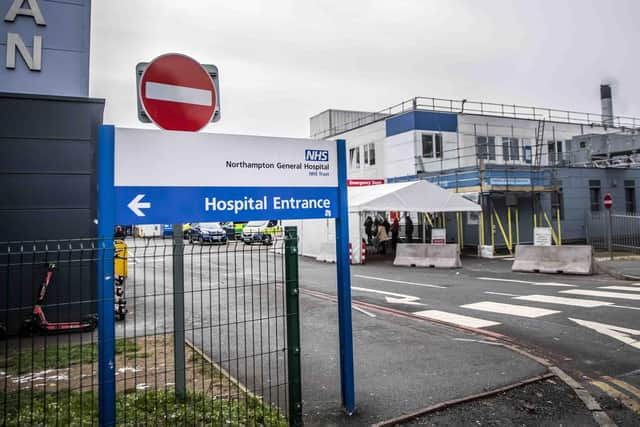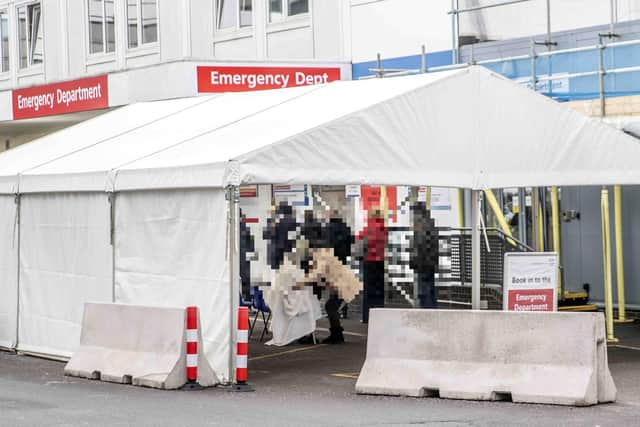Northamptonshire hospitals under ‘considerable pressure’ with rising fears from parents around scarlet fever and Strep A infections
and live on Freeview channel 276
Northamptonshire NHS Group has said both county hospitals are under “considerable pressure”, with rising fears about scarlet fever and Strep A infections among children.
It is understood that parents and guardians are struggling to get appointments with their GP for their child, and are turning to 111 and A&E to get assessed and the antibiotics needed.
Advertisement
Hide AdAdvertisement
Hide AdAs a result, a spokesperson for the University Hospitals of Northamptonshire NHS Group, which runs both Northampton and Kettering General Hospitals, has confirmed: “There have been more children than normal coming to our Emergency Departments, both in Northampton and Kettering.


“Most of these children could have been more appropriately treated in other settings.”
This comes less than two weeks after Northampton General Hospital’s chief executive Heidi Smoult addressed the growing concerns surrounding the A&E department – particularly the long wait times leaving visitors to wait outside in “poor conditions” in the gazebo, as there is not enough space inside.
The Northamptonshire NHS Group spokesperson urges parents and guardians to “choose the best place for their child’s care to help the teams in the Emergency Departments to treat patients demonstrating life threatening illnesses or injuries”.
Advertisement
Hide AdAdvertisement
Hide Ad“There may be long waits and you may be directed to other services,” added the spokesperson. “Please phone NHS 111 if your child needs urgent medical care.


“Hospitals are aware many parents are concerned about Strep A but should also be aware that many other seasonal bugs like colds and flu have similar symptoms.”
The alert statuses for both Northampton and Kettering General Hospitals could not be provided as this newspaper was told “they can change at different times of the day”.
Messaging was sent out to schools and other educational establishments last week from Directors of Public Health of both North and West Northamptonshire Councils.
Advertisement
Hide AdAdvertisement
Hide AdThey advised that scarlet fever is “not usually serious” but should be treated with antibiotics to reduce the risk of complications and spread to others.
The early symptoms include sore throat, headache, fever, nausea and vomiting.
After 12 to 48 hours, the red, pinhead rash develops, typically first appearing on the chest and stomach, then rapidly spreading to other parts of the body and giving the skin a sandpaper-like texture.
The rash may be harder to spot on darker skin, although the 'sandpaper' feel should be present. Patients typically have flushed cheeks and are pale around the mouth.
Advertisement
Hide AdAdvertisement
Hide AdThis may be accompanied by a bright red ‘strawberry’ tongue.
Once antibiotics are prescribed, the full course must be taken so the bacteria is not carried in the throat after recovery.
During this time, anyone with scarlet fever should stay at home, and away from nursery, school or work, for at least 24 hours after starting the antibiotic treatment to avoid spreading the infection.
The same bacteria which causes scarlet fever can also cause a range of other infections, including an illness called invasive group A strep (iGAS).
Advertisement
Hide AdAdvertisement
Hide AdThe messaging said: “Whilst still very uncommon, there has been an increase in iGAS cases this year, particularly in children under 10 years old.
“It is very rare for children with scarlet fever to develop an iGAS infection but as a parent, you should trust your own judgement.”
You should contact 111 or your GP if your child is getting worse, feeding or eating much less than normal, has had a dry nappy for 12 hours or more, or shows other signs of dehydration.
This should also be the case if your baby is under three months old and has a temperature of 38C, or is older than three months and has a temperature of 39C or higher. Your baby may feel hotter than usual or sweaty when you touch their back or chest.
Advertisement
Hide AdAdvertisement
Hide AdFinally, you should also monitor if your child is very tired or irritable.
999 should be phoned or A&E should be visited if your child is having difficulty breathing – which may be noticed through grunting noises or sucking their tummy in under their ribs.
You should also phone 999 or go to A&E if there are pauses when your child breathes, their skin, tongue or lips are blue, or they are floppy and will not wake up or stay still.
In the latest update by the UK Health Security Agency (UKHSA) on December 8, the statement said: “Currently, there is no evidence that a new strain of iGAS is circulating or any increase in antibiotic resistance. Antibiotics are the best treatment and work well against the circulating strains.
Advertisement
Hide AdAdvertisement
Hide Ad“The increase is likely to reflect higher susceptibility to these infections in children due to low numbers of cases during the pandemic, along with current circulation of respiratory viruses, which may increase the chances of children becoming seriously unwell.”
Investigations are underway to understand if other factors could be contributing to the increase in cases this season and who is most affected.
